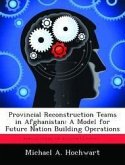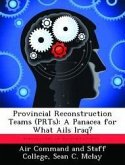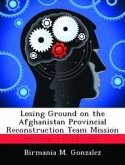The United States Government established provincial reconstruction teams (PRT) in early 2003 with the intent of spreading ISAF effects throughout Afghanistan. The mission of the PRTs was and is to increase economic and governance capacity in a province to stimulate growth and stability for the people in Afghanistan. This PRT concept did not end in Afghanistan. Civilian and military leaders in the US saw that Operation Iraqi Freedom (OIF) could benefit from leveraging the capabilities of the PRTs. Consequently, the U.S. Embassy-Iraq and MNF-I established the PRTs in Iraq with Cable 4045 in October 2005. This monograph explores the effectiveness of PRTs in Iraq by evaluating the criteria of resources, leadership structure, and operational focus. These criteria were derived by the author who provided a unique perspective from his field experience in Iraq as a theater observer for the Center for Army Lessons Learned (CALL) and a liaison officer for Multi-National Corps Iraq (MNC-I) located at the embassy in the International Zone. This monograph assesses the Afghani PRTs against these criteria during the Joint Reconstruction Team (JRT) period and the PRT period. Next it examines the same criteria in Iraq against the Coalition Provincial Authority (CPA) period), Provincial Support Teams (PST) period, PRT period, and the embedded Provincial Reconstruction Teams (ePRTs) period. All of which supports the thesis, if PRTs are going to have effectiveness in stability operations, then they need adequate resources, leadership structure, and operational focus. Finally, this monograph offers a conclusion and recommendations to improve the effectiveness of Iraqi PRTs in the future. The PRTs in Iraq require the necessary resources to fulfill their mission, and sustain itself for the short and long term. The Department of State (DOS) and Department of Defense (DOD) should consistently adjust these resources based on demands and changes in the system or environment over time. In addi








